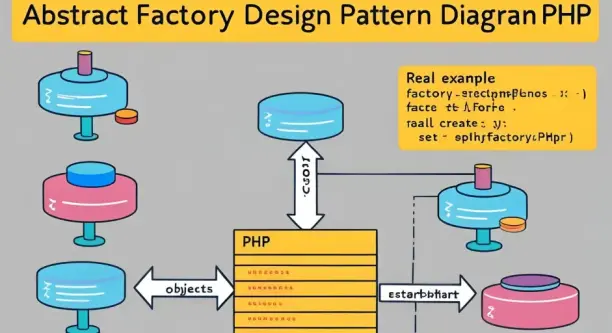Abstract Factory Design Pattern in PHP: Complete Guide with Real Examples

🔍 Introduction
Design patterns are essential to writing clean, scalable, and maintainable code. One advanced creational design pattern that often confuses developers is the Abstract Factory.
In this guide, you'll:
-
Understand what the Abstract Factory pattern is.
-
See how it differs from the Factory Method pattern.
-
Learn how to implement it in PHP.
-
View real-world examples to solidify your understanding.
-
Access useful resources for further study.
🧠 What is the Abstract Factory Pattern?
The Abstract Factory is a creational pattern that lets you produce families of related objects without specifying their concrete classes. It's often described as a "factory of factories".
Think of it like an interface for creating factories that produce related objects.
🧰 Use Cases
Use Abstract Factory when:
-
You need to create related objects (e.g., UI components for different OS).
-
You want to ensure compatibility between created objects.
-
You aim for loose coupling between object creation and usage.
🆚 Abstract Factory vs Factory Method
| Feature | Factory Method | Abstract Factory |
|---|---|---|
| Purpose | Create one object | Create families of related objects |
| Structure | Single factory method | Multiple factory methods grouped |
| Level of abstraction | Class level | Factory of factories |
| Example | One Notification type (Email/SMS) | Multiple components (Button, Checkbox) |
| Complexity | Simpler | More complex but more powerful |
🧪 Real Example in PHP (UI Theme Factory)
Let’s create a cross-platform UI toolkit with Light and Dark themes.
Step 1: Define Interfaces for Components
Step 2: Create Light Theme Components
Step 3: Create Dark Theme Components
Step 4: Create the Abstract Factory
Step 5: Implement Concrete Factories
Step 6: Client Code
✅ Output:
✅ Benefits of Abstract Factory
-
Consistency: Ensures all related components are compatible.
-
Scalability: Easily introduce new product families (e.g., NeonThemeFactory).
-
Maintainability: Reduces coupling between product creation and usage.
-
Testability: Swap out product families during testing.
🧭 When to Use It
-
Building cross-platform UI toolkits.
-
Setting up theme switchers in frontend apps.
-
Working with database engines where you want different strategies (e.g., MySQL, SQLite, PostgreSQL).
-
Developing plugin systems with multiple vendors.
🔗 Resources
🏁 Conclusion
The Abstract Factory pattern is ideal when your application requires families of related or dependent objects. It builds upon the Factory Method, offering a more scalable and extensible approach to object creation.
Using patterns like this makes your PHP code more robust, modular, and future-proof. Mastering it — especially in combination with other design patterns — will elevate your software architecture skills.
Want to dive deeper? Follow our Design Patterns category for more real-world examples with Laravel, PHP, and beyond.

Leave a comment